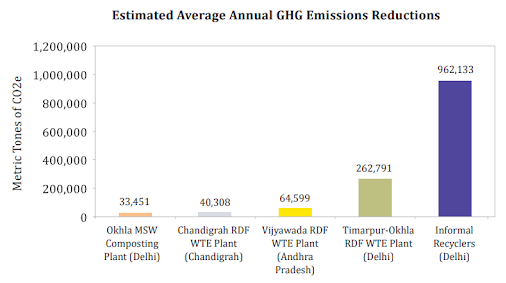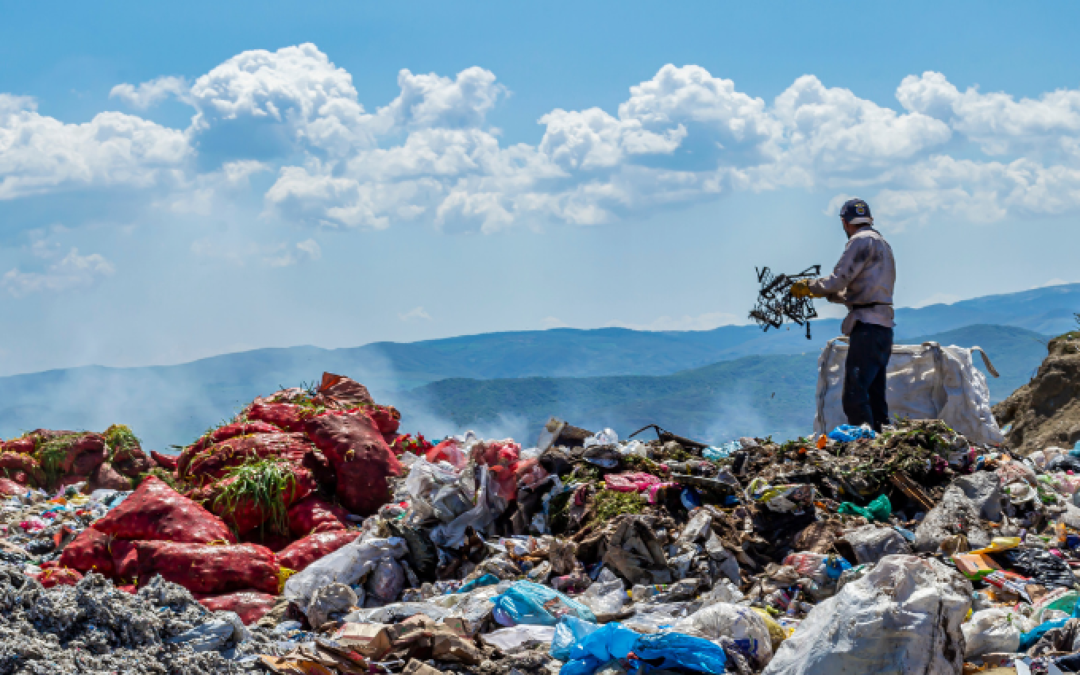Introduction
India is one of the world’s largest waste-generating nations, with approximately 62 million tonnes of municipal waste being generated annually. An average urban household in India generates around 0.5- 0.8 kg of waste per day, and this number is expected to double by the end of this decade (PIB 2016). Due to the rising population and rapid urbanisation, solid waste management (SWM) is a major issue across the country, particularly in cities. Improper SWM has caused water, air, and soil pollution. It also has a significant impact on public health as it leads to the spread of communicable diseases and releases toxins that are carcinogenic. The burning of garbage is the third largest source of greenhouse gas emissions in India (Swaminathan, 2018).
Establishing the need to Re-Model SWM
50% of the waste generated is organic/ biodegradable, which can be composted easily if appropriately segregated and individual and collective composting mechanisms exist. With urbanisation, the share of recyclables and hazardous waste is also growing. There is a positive correlation between income and waste generation as higher-income households produce more waste in comparison to lower and middle-income households. With the rising income levels in cities and the increasing convenience of purchasing packaged products, recyclable non-biodegradable waste like plastic, metal, glass, etc. are rising. The rate of processing of municipal waste is less than 15%, and 30% of the waste generated is unaccounted for, indicating that the waste is dumped in illegal sites (CPCB, 2021). Hence, it is necessary to remodel the current systems of waste management in order to transition into a circular economy.

In the notable judgement of the Supreme Court in the Almitra H. Patel v. Union of India (2000) case, it was highlighted that in order to effectively manage solid waste there was a need for decentralisation of waste management in the country. Decentralisation of waste management requires the integration of the informal sector and a larger participation of the community in segregating and recycling waste. Moreover, the court also recommended the conversion of waste into energy in accordance with the principles of circular economy. According to the Solid Waste Management Rules of 2016, waste pickers, kabadiwalas and self-help groups are to be integrated into the formal sector for effective SWM.
Contribution of Informal Sector
The informal sector plays a crucial role in the management of waste in urban areas. The Centre for Science and Environment found that 15,000 waste pickers divert more than 4 lakh tonnes of waste from landfills every year. India’s recycling rate of plastic is around 60% which is much higher than the global average of 14%. This is maintained successfully by the chain of informal workers, in the following manner: The waste is collected by the waste pickers who segregate the waste according to the material. This waste is sent to kabadiwalas or scrap dealers who further channel it to recyclers. By law, the responsibility of municipal solid waste lies with the urban local bodies. Though the collection is handled by them, the waste is unloaded at landfills and dumpsites without segregation. The waste-pickers scrouge through the mountains of waste to retrieve recyclable materials and further send the recyclables for recycling.

In Indian cities like Delhi and Bangalore, waste pickers save the government and tax-payers around $13,700 per day in waste disposal and collection costs. 15 lakh waste pickers across the country save municipalities ₹54.75 crores annually (Chintan, 2018). They also help in the value addition of discarded materials like plastic, metal, glass, etc. The informal SWM sector employs 1% of India’s urban population (Chintan, 2018). Therefore, making it a source of urban livelihood for economically disadvantaged groups. This model of regeneration and restoration of materials contributes to the creation of a circular economy which can help in tackling the climate crisis. A recent study showed that waste pickers recovered almost 23% of waste, and a single waste picker collects 60-90 kg of recyclable waste, every day (Kumar, A & Agrawal, A, 2020), (Singh, 2021). A key recommendation by several legislations for managing SWM has been segregation at source, which is mainly done by waste pickers at present, even though this responsibility is of the waste generator. Recycling done by waste pickers helps in the prevention of water-logging and flooding in cities. They also prevent waste from going to incineration, diverting it to recyclers and upcyclers. The 5R principle of refusing, reducing, reusing, repurposing and recycling is a measure for attaining a circular economy, and the informal sector largely contributes to this.
Socio-Economic Conditions of Waste-Pickers
The National Action Plan for Climate Change 2009 identifies the informal sector as the “backbone” of India’s recycling sector. There are several regional and central legislations that recognise their contributions and emphasise the need to integrate them into the formal sector in order to improve their working conditions and social security. Nevertheless, the rate of implementation of these laws is abysmal.
India has around 1.5- 4 million waste pickers, with over 2 million living off dumping grounds (Swaminathan, 2018). The majority of the waste pickers are women and children. The WIEGO (Women in Informal Employment: Globalizing and Organizing) network, describes waste picking as the lowest in the hierarchy of urban informal occupations. The work is mainly done by persons of the lowest castes, migrants, and other marginalised communities. Most of them are subject to discrimination and exploitation and lead their lives in unhygienic conditions and poverty. Due to the lack of adequate safety equipment, the chances of injury and disease are extremely high for them as dumping grounds often have hazardous chemicals, glass, and rodents. Many suffer from lung problems, malnutrition, dog bites, worm infestations, etc. They are also subject to homelessness and have long working hours. A report by the UNDP showed that 7 out of 10 waste pickers earn less than ₹10,000 a month, with women earning less than men. The lack of regulation in the informal sector shows how they have been undervalued and uncompensated for.
Waste pickers are often mistaken as thieves and harassed by police and other authorities. Despite their dangerous job, the non-recognition has also excluded them from healthcare policies and welfare programmes making them doubly disadvantaged. There is also an increased effort in the privatisation of SWM to large private companies by urban local bodies which has resulted in the loss of jobs and further marginalisation of the communities. In Delhi, informal waste pickers account for the reduction of carbon dioxide emissions by 9.6 lakh metric tonnes, which is triple the amount of reduction done by the existing waste plants. However, around 50% of them lost their jobs due to the government’s decision to privatise the sector (Chintan, 2018).

Conclusion: Potential Suggestions for Way Forward
The role of waste pickers has a massive positive externality for the environment and society. They are “invisible environmentalists” who help in reducing pollution, improving the cleanliness of cities, and preventing the spread of diseases. They are important economic agents who retrieve raw materials and provide them to industries. Economic incentives and social welfare schemes should be in place to enhance their status and manage waste in cities effectively. Formalising their work and giving them fair wages must be a priority of the state. It must also be ensured that the workers have proper safety equipment and that children are not involved in the process. Financial inclusion and improving their access to recycling technologies will help in providing security to their livelihoods.
In order for India to transition from a linear economy to a circular economy, these informal waste pickers need to be integrated into the formal sector making a more inclusive and sustainable form of development.
References
-
- Swaminathan, M. (2018, November 28). How Can India’s Waste Problem See a Systemic Change? Economic and Political Weekly. https://www.epw.in/engage/article/institutional-framework-implementing-solid-waste-management-india-macro-analysis#:~:text=Waste%20Generation%20in%20India,4%25%20(PIB%202016)
- Kumar, A., & Agrawal, A. (2020). Recent trends in solid waste management status, challenges, and potential for the future Indian cities – A review. Current Research in Environmental Sustainability, 2, 100011. https://doi.org/10.1016/j.crsust.2020.100011
- Waste Pickers | WIEGO. (n.d.). https://www.wiego.org/waste-pickers#org
- Del Pilar Moreno-Sanchez, R., & Maldonado, J. H. (2006). Surviving from garbage: the role of informal waste-pickers in a dynamic model of solid-waste management in developing countries. Environment and Development Economics, 11(3), 371–391. https://doi.org/10.1017/s1355770x06002853
- Chaturvedi, A., & Gaurav, J. K. (2016). Managing Waste in India with Foresight. IDS Bulletin, 47(4).
- Dias, S. (2016). Waste pickers and cities. Environment and Urbanization, 28(2), 375–390. https://doi.org/10.1177/0956247816657302
- Chintan Environmental Research and Action Group. (2018). Wastepickers: Delhi’s Forgotten Environmentalists? https://www.chintan-india.org/sites/default/files/2019-09/Supreme%20Court%20Report_01.pdf
- Ministry of Housing and Urban Affairs, GoI. (2021). Circular Economy in Municipal Solid and Liquid Waste. https://mohua.gov.in/pdf/627b8318adf18Circular-Economy-in-waste-management
- Singh, S. (2015). Decentralized Solid Waste Management in India: A Perspective on Technological Options. CITIES- the 21st Century India, 289–304.
- Central Pollution Control Board. (2022). Annual Report on Implementation of Solid Waste Management Rules, 2016 (2020-21) https://cpcb.nic.in/uploads/MSW/MSW_AnnualReport_2020-21.pdf
- Singh, R. (2021). Integration of Informal Sector in Solid Waste Management: Strategies and Approaches, Centre for Science and Environment.


Recent Comments